9 Species of Hawks in Ohio (With Pictures & Info)
Last Updated on
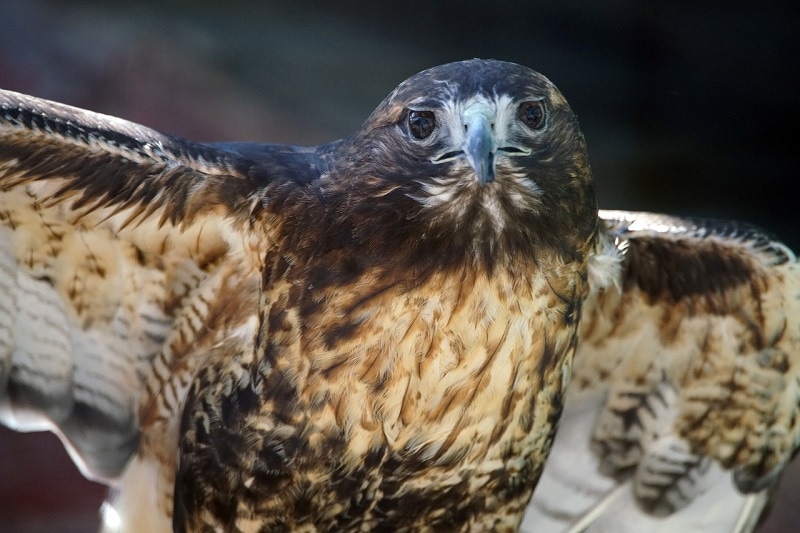
With its lush woodlands, grasslands, and several prominent rivers, Ohio provides an ideal environment for hawks. There are an estimated 25 different hawk species across the United States, and each state has its own collection of hawk species depending on the climate and food sources that the hawks need. Many hawk species are migratory and may spend different parts of the year in different states, but several are year-round residents of Ohio.
Hawks are among nature’s most lethal hunters, with razor-sharp vision, acute hearing, and high-speed flying capability. They fall into the Accipitridae family, which includes hawks, eagles, kites, and vultures, and many form life-long pair bonds.
There are nine different species of hawk that can be found in Ohio, and if you’d like to know more, read on for in-depth information about these magnificent animals.

1. Broad-Winged Hawk
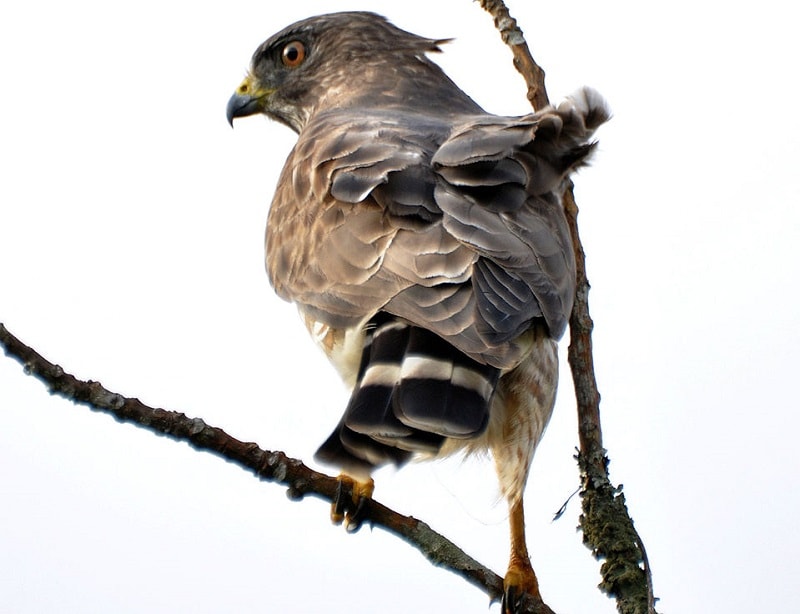
- Scientific name: Buteo platypterus
- Lifespan: 10-14 years
- Wingspan: 29-39 inches
- Length: 13-17 inches
Broad-Winged Hawks are usually only found in Ohio throughout their breeding months, which lasts from April to August, after which they head south for the winter. This large migration is a spectacular sight, often with many thousands of hawks traveling at once in large groups called “kettles.”
They are small to medium-sized birds with short but broad wings that have a unique tapered appearance. They typically have dark brown plumage above with brown-barred, white plumage underneath, but there is also a lighter morph that has more white coloring. Their populations are unfortunately declining due to the shrinking forest habitats in which they thrive.
2. Cooper’s Hawk
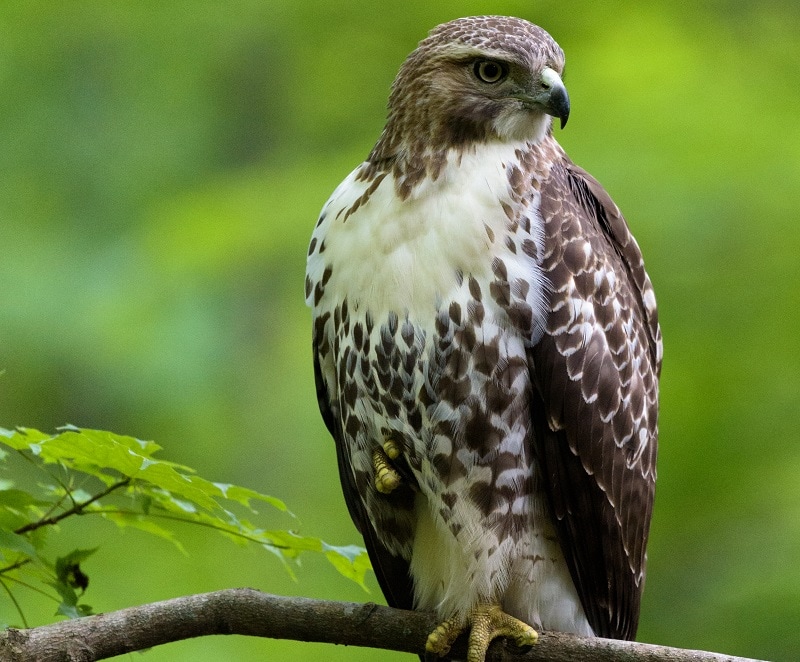
- Scientific name: Accipiter cooperii
- Lifespan: 10-12 years
- Wingspan: 24-39 inches
- Length: 14-20 inches
Named after the famed ornithologist, William Cooper, the Cooper’s Hawk is often confused with the similar Sharp-Shinned Hawk but is a fair bit larger. They can be found in a large range of habitats, from mixed forests to woodlands, and build bulky nests high up in the forks of trees. They are also commonly found in wooded suburban areas and are notorious for stalking bird feeders. The Cooper’s Hawk can be found year-round in Ohio.
They have a varied plumage, ranging from blue-grey to brown-grey in color, with a creamy underside with red-brown bands. They have powerful, strong legs with thick talons, allowing them to hunt larger prey than most hawks. They are also exceedingly agile, fast, and aggressive hunters, feeding mostly on small birds, mammals, and reptiles.
3. Northern Goshawk

- Scientific name: Accipiter gentilis
- Lifespan: 10-12 years in the wild, up to 27 years in captivity
- Wingspan: 35-50 inches
- Length: 18-27 inches
The large, powerful Northern Goshawk is the quintessential aerial predator, with menacing red eyes, a black beak, a dark brown back, and black-and-white striped front. They are known for being powerful hunters, using a combination of concealment, unmatched agility, and high speed to ambush their prey, which includes a wide variety of up to 500 different species. They typically breed north of Ohio in summer and can only be found in the state during the winter months.
They are a scarce species that can be difficult to spot because they nest high up in trees. They are mainly found in the northern areas of Ohio, which is where you are more likely to spot one. Keep in mind that the Northern Goshawk is a fiercely territorial animal and one of the most aggressive American Raptors and has even been known to attack humans in the protection of their nests.
4. Northern Harrier

- Scientific name: Circus hudsonius
- Lifespan: 12-16 years
- Wingspan: 38-48 inches
- Length: 16-20 inches
The only Harrier species in North America, the Northern Harrier is a large hawk, with an exceptionally long wingspan and distinctively long tail. Their breeding grounds range as far north as Canada, but they will winter in Ohio and other southern states. Unlike most hawk species, Northern Harriers are not monogamous and will mate with several females, sometimes up to five, during breeding season. They prefer open grasslands and wetlands over forests, and they nest on the ground in dense vegetation.
Northern Harrier males have dark grey upper plumage, and females are dark brown, with both having white plumage below with grey or brown banding.
5. Red-Shouldered Hawk
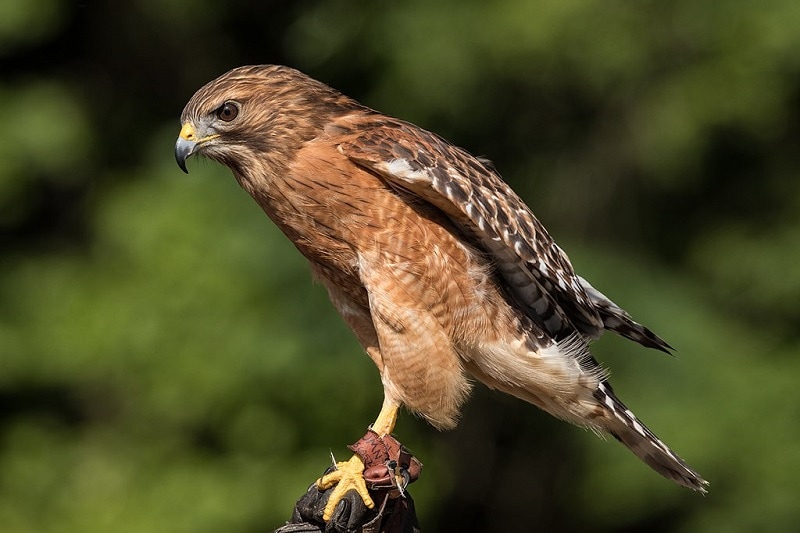
- Scientific name: Buteo lineatus
- Lifespan: 15-19 years
- Wingspan: 35-50 inches
- Length: 15-25 inches
The Red-Shouldered Hawk gets their name from the red and brown streaks that line the upper parts of their wings, and they are one of the most attractive species of hawk. They also have a warm red and white breast and belly, with long yellow legs and a long tail. They are large birds that live in woodlands and forests near rivers and wetlands and are year-round residents of Ohio.
Sadly, deforestation is destroying much of their preferred habitat, although they are adaptable birds that can often be found in urban wooded areas too. They are known to nest in large dead trees, where leaves will not obscure their view, and they are one of the few species that return to their nests every breeding season.
6. Red-Tailed Hawk

- Scientific name: Buteo jamaicensis
- Lifespan: 20-25 years
- Wingspan: 45-55 inches
- Length: 18-26 inches
One of the most widespread and successful hawk species in the United States, the Red-Tailed Hawk is also one of the largest. They are incredibly adaptable raptors that can live in a wide range of environments, and this is a large part of what makes the species so prolific. They favor open grasslands and croplands but are also often found in forests and urban areas. They have a distinctive rusty-red tail, from which they get their name, but the rest of their plumage can vary widely. There are 14 different subspecies, all with unique plumage. One of the most common hawk species in Ohio, the Red-Tailed Hawk can be found in the state year-round.
They typically nest high up in the canopy of tall trees and make good use of telephone poles, buildings, and towers. The feathers of the Red-Tailed Hawk are considered sacred by some Native American populations and used extensively in ceremonies.
7. Rough-Legged Hawk

- Scientific name: Buteo lagopus
- Lifespan: 5-18 years
- Wingspan: 50-60 inches
- Length: 18-24 inches
Along with the Ferruginous Hawk, the Rough-Legged Hawk is the only American hawk species to have feathered legs all the way down to their toes. These feathered toes serve a vital purpose, keeping their legs warm as they breed in the arctic and then migrate down to the south during winter. They come in two distinct variations: light morph, with an overall lighter and mottled plumage, and dark morph, a dark brown plumage with two-tone wings.
They prefer to live near open fields where there is more of their natural prey, small rodents and birds. They have a non-breeding range throughout Ohio, so you’ll only spot them during the winter months.
8. Sharp-Shinned Hawk
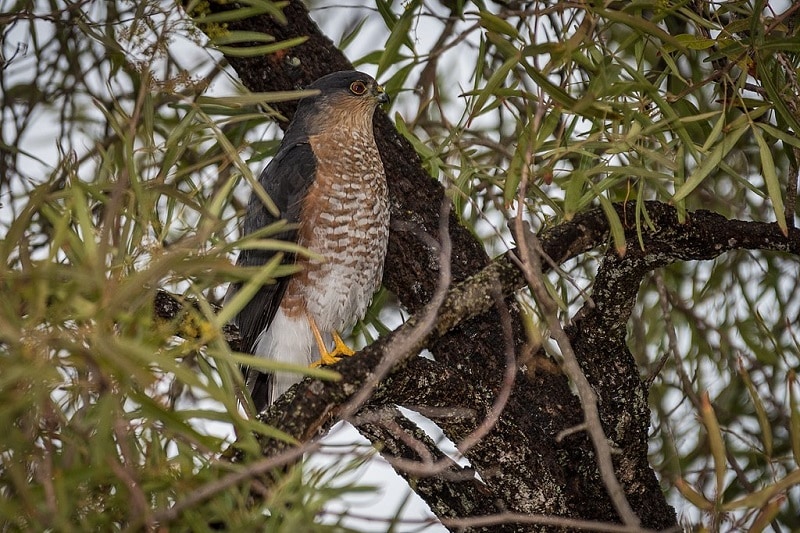
- Scientific name: Accipiter striatus
- Lifespan: 3-10 years
- Wingspan: 17-25 inches
- Length: 9-15 inches
The Sharp-Shinned Hawk is the smallest hawk species in North America, with broad, rounded wings and slender yellow legs from which they get their name. There are various sub-species of Sharp-Shinned hawks, all with varying plumage, but the Sharp-Shinned hawks in Ohio are blue-grey above with brown-barred white plumage below. They can be found in southern Ohio year-round but have a non-breeding range in northern Ohio.
These little hawks are agile hunters, often catching small sparrows and warblers in mid-flight. They prefer wooded areas and thickets, and you’ll rarely spot them in open areas. Their populations were once under threat due to pesticide poisoning, but since the banning of DDT, they are once again thriving.
9. Swainson’s Hawk

- Scientific name: Buteo swainsoni
- Lifespan: 15-20 years
- Wingspan: 45-55 inches
- Length: 17-22 inches
The Swainson’s Hawk is commonly known as the “locust hawk” due to their appetite for these insects, which make up a large part of their diet. The species is exceedingly rare in Ohio, with very few annual sightings. They breed mostly in the western parts of North America and migrate south during the winter months. They have a dark brown upperpart, with white under plumage and a characteristic red chest patch.
They prefer open grasslands and prairies, as this is where they are easily able to find insects to feed on. They typically nest in small bushes and shrubs along rivers and cliffs but occasionally nest in small trees too.

Conservation
Throughout the last few decades, many hawk species in Ohio have been facing massive threats to their environment from deforestation, pesticide poisoning, and even purposeful poisoning. That said, due to responsible agricultural practices and protection efforts through legislation, the numbers of most of these species have been gradually increasing. Thankfully, hawks are now federally protected in Ohio, and it is illegal to harm, trap, cage, shoot, or poison them without a permit, and doing so can result in a fine of up to $15,000.
Check out some of our top ranking posts:
- 2 Species of Eagles in California (with Pictures)
- 8 Species of Hawks in Michigan
- 9 Hawk Species Found in Florida
- 18 Types of of Ducks Found in Ohio (with Pictures)
Featured Image Credit: gayleenfroese2, Pixabay
About the Author Robert Sparks
Robert’s obsession with all things optical started early in life, when his optician father would bring home prototypes for Robert to play with. Nowadays, Robert is dedicated to helping others find the right optics for their needs. His hobbies include astronomy, astrophysics, and model building. Originally from Newark, NJ, he resides in Santa Fe, New Mexico, where the nighttime skies are filled with glittering stars.
Related Articles:
Monocular vs Telescope: Differences Explained (With Pictures)
How to Clean a Refractor Telescope: Step-by-Step Guide
How to Clean a Telescope Eyepiece: Step-by-Step Guide
How to Clean a Rifle Scope: 8 Expert Tips
What Is a Monocular Used For? 8 Common Functions
How to Clean a Telescope Mirror: 8 Expert Tips
Brightfield vs Phase Contrast Microscopy: The Differences Explained
SkyCamHD Drone Review: Pros, Cons, FAQ, & Verdict
